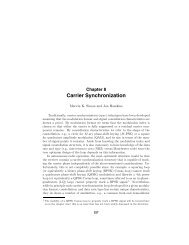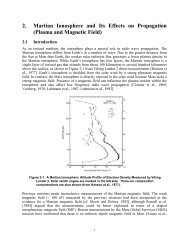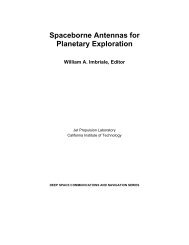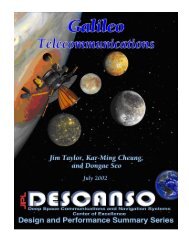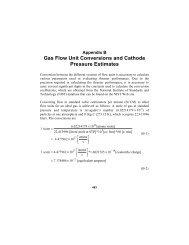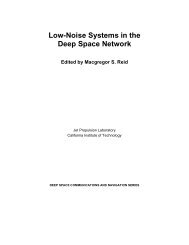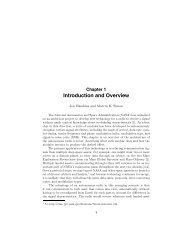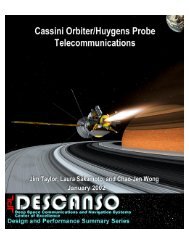Propagation Effects Handbook for Satellite Systems - DESCANSO ...
Propagation Effects Handbook for Satellite Systems - DESCANSO ...
Propagation Effects Handbook for Satellite Systems - DESCANSO ...
You also want an ePaper? Increase the reach of your titles
YUMPU automatically turns print PDFs into web optimized ePapers that Google loves.
has been presented by Muchmore and Wheelon (1955). The derivation<br />
employs a ray theory approach and assumes an exponental spatial<br />
correlation <strong>for</strong> the turbulence scale. uo is in radians, 4 is the<br />
scale length of the turbulent eddy, Lt is the path length through the<br />
turbulence, ~ is wavelength, and ~z is the mean-square fluctuation<br />
in the refractivity N. When using this expression, one should only<br />
assume values of 4 and A~z such that<br />
The results of using this relation at the limiting values of<br />
4LNZ <strong>for</strong> 3 and 10 GHz are presented in Figure 6.5-11. Typical<br />
values of 4 are 60 meters and ~z = 1/2. This modeW indicates that<br />
the phase delay fluctuations increase linearly with frequency and<br />
become significantly less if the antenna diameter approaches the<br />
scale length.<br />
Another technique <strong>for</strong> estimating these phase delay fluctuations<br />
based on the monthly variance of the surface refractivity and<br />
estimates of the frequency spectrum of the delay fluctuation have<br />
been made by Nusple, et al (1975).<br />
6.5.3.2 Estimate of Phase Ripp le <strong>Effects</strong> on Earth-Space Paths.<br />
Accompanying the amplitude scintillations of a plane wave<br />
propagating through tropospheric turbulence are transverse phase<br />
ripple variations. According to the theory of Tatarski (1961) the<br />
mean-square phase variation over a distance transverse to the<br />
propagation path is.:<br />
Da(pa) = K@ Cno2(2n/~)2 LTp@Si3 (6.5-7)<br />
where ~ is wavelength, Lt is the propagation path length through the<br />
region of turbulence, and Cno is the surface structure constant. The<br />
constant K is equal to 2.91 <strong>for</strong> the exponential Czn model (Tatarski-<br />
1961) and equal to 4.57 from Ohio data (Theobold and Hedge-1978).<br />
This expression may be ,used to estima” -<br />
the expected mean-square<br />
6-92<br />
-.





